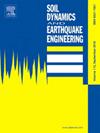Seismic performance of CFST piers in two-span continuous girder bridge under multiple earthquakes using endurance time analysis
IF 4.2
2区 工程技术
Q1 ENGINEERING, GEOLOGICAL
引用次数: 0
Abstract
Existing research on the seismic performance of bridge structures predominantly focuses on the effects of the single earthquake, often neglecting the impact of multiple earthquakes. This study aims to address this gap by analyzing the dynamic response characteristics of a two-span continuous girder bridge with concrete-filled steel tube (CFST) piers subjected to multiple earthquakes. A detailed finite element (FE) model of the bridge is developed using solid-shell elements, incorporating a combined hardening–ductile damage model for steel and a confined concrete triaxial plasticity–damage model. Following the principles of the Endurance Time Analysis (ETA) method, two seismic time-history curves are derived from the response spectrum design and used to generate twelve seismic wave inputs. The study investigates the lateral deformation characteristics and damage failure patterns of the CFST piers in the two-span continuous girder bridge under sequential earthquake loading. The findings indicate that: (1) The ETA method provides a novel and efficient approach for studying the seismic performance of structures subjected to multiple earthquakes. (2) For structures already damaged by earlier earthquakes, lateral deformation analysis must account for the peak intensity ratio (β) between successive earthquakes. (3) As earthquake intensity and associated structural damage increase, the threshold value of β required to initiate further damage from subsequent earthquakes decreases, thereby increasing the likelihood of more severe damage.
多震作用下两跨连续梁桥钢管混凝土桥墩抗震性能耐久性分析
现有的桥梁结构抗震性能研究主要集中在单次地震的影响上,往往忽略了多次地震的影响。本研究旨在通过分析双跨钢管混凝土桥墩连续梁桥在多次地震作用下的动力响应特性来解决这一问题。采用实体-壳单元建立了桥梁的详细有限元模型,包括钢的硬化-延性联合损伤模型和约束混凝土的三轴塑性-损伤模型。根据耐久性时间分析(ETA)方法的原理,从反应谱设计中得到两条地震时程曲线,并用于产生12个地震波输入。研究了连续地震作用下两跨连续梁桥钢管混凝土桥墩的侧向变形特征及破坏破坏模式。研究结果表明:(1)ETA方法为研究结构在多次地震作用下的抗震性能提供了一种新颖有效的方法。(2)对于已经受到早期地震破坏的结构,侧向变形分析必须考虑连续地震之间的峰值烈度比(β)。(3)随着地震烈度和相关结构破坏的增加,引发后续地震进一步破坏所需的β阈值降低,从而增加了发生更严重破坏的可能性。
本文章由计算机程序翻译,如有差异,请以英文原文为准。
求助全文
约1分钟内获得全文
求助全文
来源期刊

Soil Dynamics and Earthquake Engineering
工程技术-地球科学综合
CiteScore
7.50
自引率
15.00%
发文量
446
审稿时长
8 months
期刊介绍:
The journal aims to encourage and enhance the role of mechanics and other disciplines as they relate to earthquake engineering by providing opportunities for the publication of the work of applied mathematicians, engineers and other applied scientists involved in solving problems closely related to the field of earthquake engineering and geotechnical earthquake engineering.
Emphasis is placed on new concepts and techniques, but case histories will also be published if they enhance the presentation and understanding of new technical concepts.
 求助内容:
求助内容: 应助结果提醒方式:
应助结果提醒方式:


